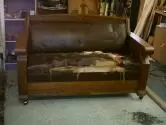To Share Or Not To Share? – That Was the Question

While many of you may not have been collecting Arts & Crafts in the 1970s and 1980s, for those of us who had started to notice this distinctly American style of furniture, art pottery, metalware and architecture, it was a time of excitement – and of frustration.
Any of the standard American antique furniture books which had noted the existence of the Arts & Crafts movement delegated a scant few pages near the end to chapters entitled “Mission Oak,” “Mission Style” or my personal favorite “The Chunky Charm of Mission Oak.”
And while these perfunctory overviews provided some biographical information on Gustav Stickley and Elbert Hubbard, they left us clueless when it came to identifying their furniture, much less determining which examples were rare and unusual versus those which were more common.
I am sure I walked by several examples of rare, early Gustav Stickley furniture as I was lugging home that damnable Sears & Roebuck mission style hide-a-bed that weighed two tons and threatened to suffocate any guest forced to spend a night gingerly tossing and turning over the steel supports beneath a paper-thin mattress.
Unbeknownst to all but a few early Arts & Crafts collectors, manufacturers such as Gustav Stickley, the Roycrofters, L. & J.G. Stickley, Charles Limbert and Stickley Brothers had issued illustrated catalogs containing photographs and drawings of their furniture, along with dimensions and shopmarks. Savvy early collectors snapped up copies whenever they appeared on the market, for they realized these catalogs were worth hundreds of thousands of dollars for the information they contained. Early, experimental and custom pieces which bore no shopmarks could be positively identified — but only if you had the right original catalog.
You can imagine, then, the scorn they heaped upon Stephen Gray, himself a prominent Arts & Crafts collector, who made the decision to publish quality reprints of many of the original catalogs he had acquired. Stephen could have kept them to himself, eliminating much of the competition for pieces he sought for his own collection. Instead, he began preparing them for publication and national distribution, knowing full well that the profits from these catalogs would never equal what he could have made had he kept them to himself.
I bought my first copies in 1981, when I was living in Iowa City, and nearly wore them out in my travels around the Midwest. I soon bought a second set just to keep in my battered Ford van. I lost count of the number of discoveries I made just by being able to refer to one of the catalogs Stephen Gray had published through Turn of the Century Editions, but it was significant. I still have that first set, complete with notations, names and phone numbers I had scribbled in the margins.
While Stephen has since handed off Turn of the Century Editions to Peter and Janet Copeland, publishers of the Parchment Press, I am sure he feels a great deal of gratification knowing that thirty years later his reprint catalogs are still available and still helping Arts & Crafts collectors.
And, so, I would like to offer my personal thanks to Stephen Gray and to congratulate him upon being nominated for and soon to be conferred with the Arts & Crafts Lifetime Achievement Award.
Had it not been for him, I might still have that Sears & Roebuck mission hide-a-bed.
Thanks, Stephen!

Until next Monday,
Bruce Johnson
To see a complete listing of reprint furniture catalogs now available, please go to http://www.turnofthecenturyeditions.com.
